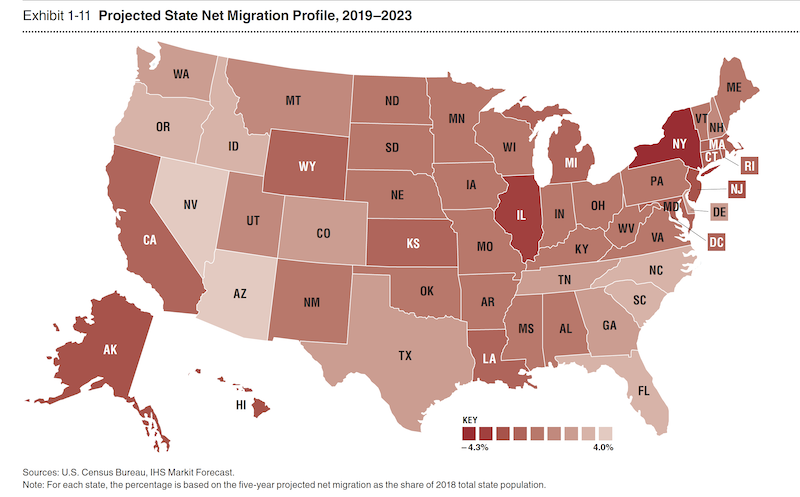The current record-setting expansion in the U.S. economy and its real estate sector, which dates back to the start of this decade, should continue through 2021, but at a moderated pace.
That’s the consensus prediction, based on a recent survey of 41 economists and analysts at 32 leading real estate organizations. Those experts’ opinions about all things real estate—from transaction volumes and pricing to returns on investment and housing development—form the basis of the Urban Land Institute’s Real Estate Economic Forecast, which ULI released last week.
The trends that are likely to drive the pace of that growth are identified in Emerging Trends in Real Estate 2020, which ULI and PwC, the accounting and research firm, released last month. That 92-page report is based on survey responses from 1,450 people working for various real estate-related businesses (nearly 28% of whom are private property owners or developers), and 750 individuals whom the report’s researchers interviewed personally.
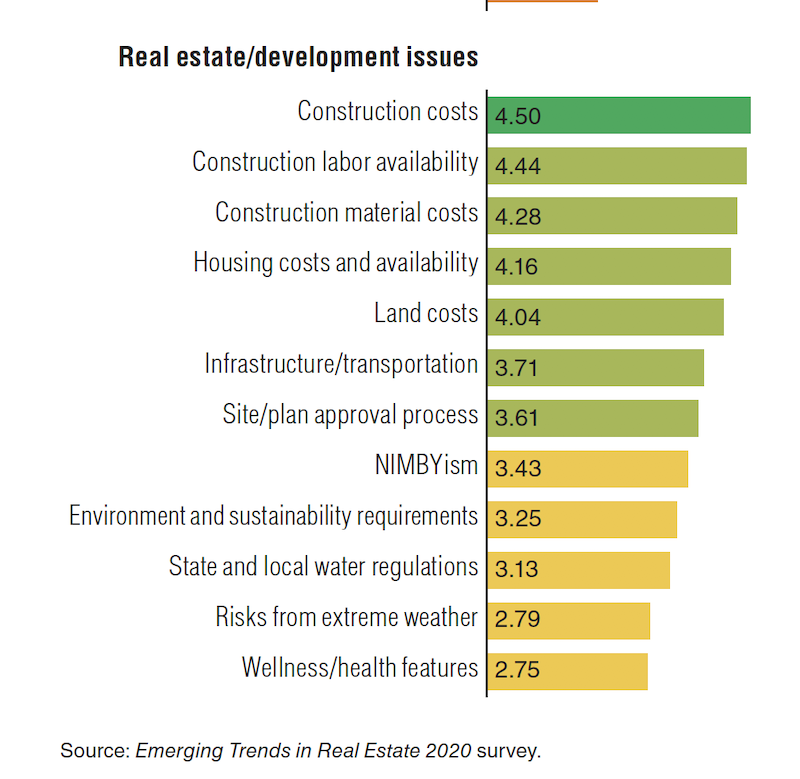
Rising construction costs lead the areas of concern that could stymie real estate growth.
Austin ranks first out of 80 metros in the U.S. for having the greatest potential for real estate for 2020, followed by Raleigh-Durham, N.C., Nashville, Charlotte, and Boston. The Emerging Trends report assesses which markets are worth watching by six criteria that include population projections, homebuilding prospects, investor demand, and redevelopment opportunities.
Manhattan and Chicago will continue to lead the pack as capital magnets for real estate investment. Philadelphia and Long Island, N.Y., are among the metros with sustained track records for capital flow and transaction volume. And Jacksonville, Fla., Salt Lake City, and Columbus, Ohio, are deemed “treasures ripe for discovery.”
The report makes “buy-hold-sell” recommendations within metros for different building types. For example, nearly three-fifths of respondents gave Oakland/East Bay in California a “buy” recommendation for office properties. Orlando ranked highest for multifamily properties, Nashville for retail, Charleston, S.C., for hotels.
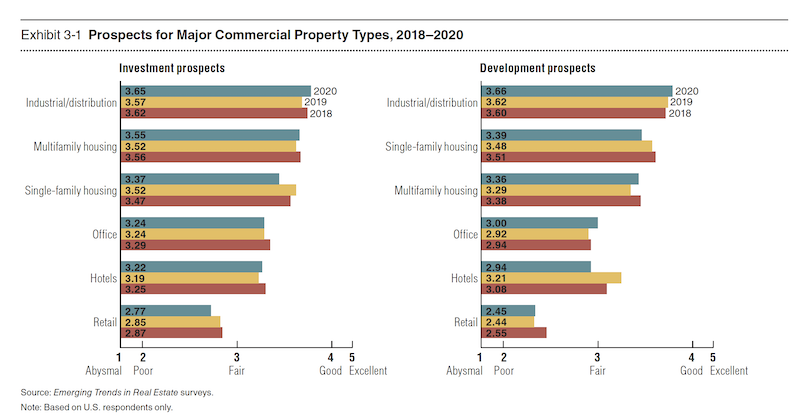
Warehouse distribution, in an era of online shopping, continues to be seen as fertlle for future development.
Nationally, industrial buildings, such as warehouses, have the greatest prospects among commercial real estate property types for 2020 in terms of their return performance and growth outlook, followed by multi- and single-family housing.
This report, though, isn’t all upbeat. Among the trends it spots is an “extended downshifting” in the economy, which is likely to have implications for commercial property demand “in the decades ahead.” The report warns against “a surfeit of capital desperately seeking placement,” which could create a real estate bubble. And the repot sees affordable housing at “a breaking point” of inadequate supply. One attempted solution: the rise in coliving.
The report sees increasing demand for communities that can deliver an authentic sense of place “rather than concocted through prescribed programming and business goals.” It also sees live-work-play districts breaking out of their urban enclaves and expanding to suburban communities to create “hipsturbias.” Real estate development in “hipsturbs” and urban downtowns should benefit from baby boomers’ expectations of staying active as they age.
Infrastructure construction and improvement are more likely to be initiated by state and local, rather than federal, governments that see them as foundations of their cities’ economic growth. And property managers are turning to technology for productivity enhancements and operational efficiencies.
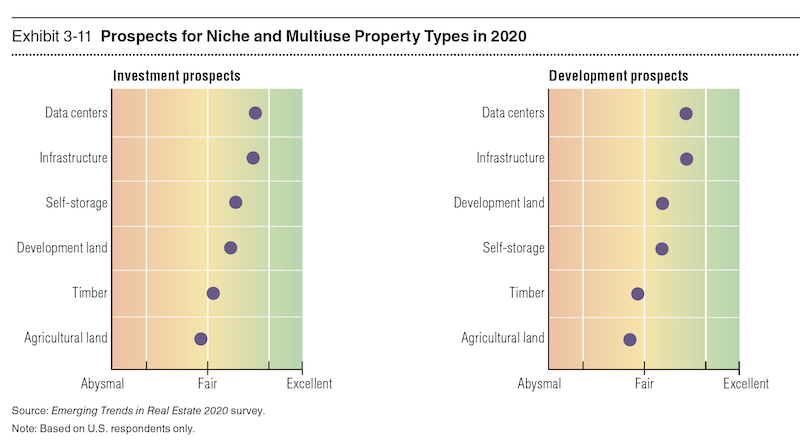
Data centers and infrastructure are two building types where experts foresee better than average growth prospects.
Many of these trends are premised on economic assumptions that ULI lays out in its Real Estate Economic Forecast. It expects the U.S. gross domestic product to increase by 2.3% this year 1.7% next year, and 1.9% in 2021. Net job growth should average 1.7 million per year through 2021. Yields on 10-year U.S. Treasury notes are expected to decline, which ULI states “should be a positive for real estate values.”
Real estate transaction volumes are expected to moderate over the forecast period, from a projected $475 billion this year to $415 billion in 2021. Real estate price growth is also expected to slow, from 5.1% this year to 3.9% in 2021.
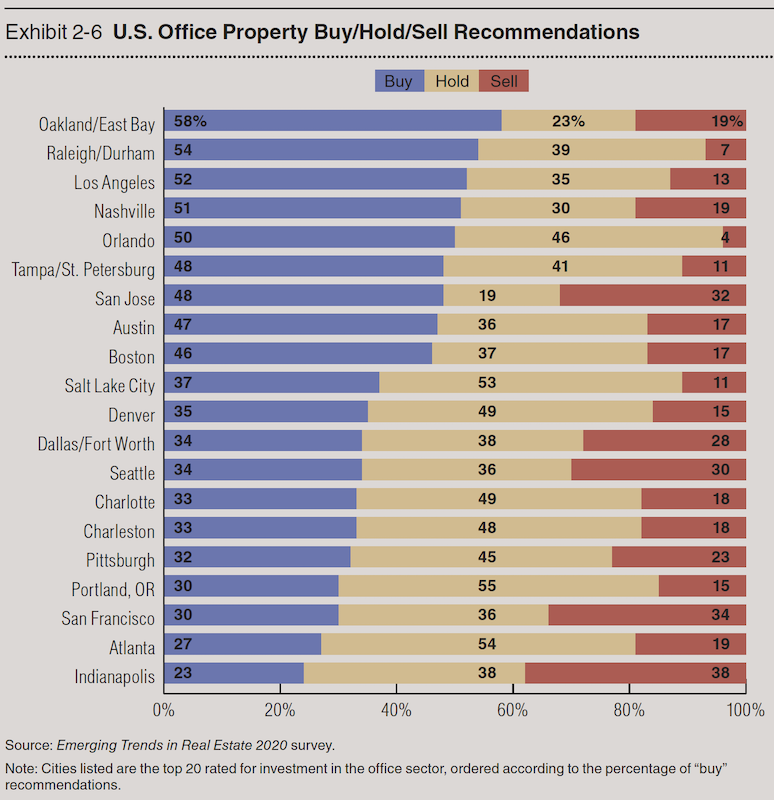
The Oakland, Calif., market remains ripe for office development and construction.
Rent growth should be flat for all building types except industrial and hotels, which will see declines. National vacancy rates will rise slightly, predicts economists.
Total real estate returns, as well as equity real estate investment trust returns, are expected to be strong over the next two years. On the flip side, increasing construction costs are tamping down single-family housing, to the point where ULI’s report is forecasting an annual average, through 2021, of between 800,000 and 850,000 units delivered, well below the long-term annual average of 975,000. Home prices, though, should continue to average 3.2% growth per year over the forecast period.
Related Stories
Contractors | Jun 13, 2023
The average U.S. contractor has 8.9 months worth of construction work in the pipeline, as of May 2023
Associated Builders and Contractors reported that its Construction Backlog Indicator remained unchanged at 8.9 months in May, according to an ABC member survey conducted May 20 to June 7. The reading is 0.1 months lower than in May 2022. Backlog in the infrastructure category ticked up again and has now returned to May 2022 levels. On a regional basis, backlog increased in every region but the Northeast.
Industry Research | Jun 13, 2023
Two new surveys track how the construction industry, in the U.S. and globally, is navigating market disruption and volatility
The surveys, conducted by XYZ Reality and KPMG International, found greater willingness to embrace technology, workplace diversity, and ESG precepts.
| Jun 5, 2023
Communication is the key to AEC firms’ mental health programs and training
The core of recent awareness efforts—and their greatest challenge—is getting workers to come forward and share stories.
Contractors | May 24, 2023
The average U.S. contractor has 8.9 months worth of construction work in the pipeline, as of April 2023
Contractor backlogs climbed slightly in April, from a seven-month low the previous month, according to Associated Builders and Contractors.
Multifamily Housing | May 23, 2023
One out of three office buildings in largest U.S. cities are suitable for residential conversion
Roughly one in three office buildings in the largest U.S. cities are well suited to be converted to multifamily residential properties, according to a study by global real estate firm Avison Young. Some 6,206 buildings across 10 U.S. cities present viable opportunities for conversion to residential use.
Industry Research | May 22, 2023
2023 High Growth Study shares tips for finding success in uncertain times
Lee Frederiksen, Managing Partner, Hinge, reveals key takeaways from the firm's recent High Growth study.
Multifamily Housing | May 8, 2023
The average multifamily rent was $1,709 in April 2023, up for the second straight month
Despite economic headwinds, the multifamily housing market continues to demonstrate resilience, according to a new Yardi Matrix report.
Market Data | May 2, 2023
Nonresidential construction spending up 0.7% in March 2023 versus previous month
National nonresidential construction spending increased by 0.7% in March, according to an Associated Builders and Contractors analysis of data published today by the U.S. Census Bureau. On a seasonally adjusted annualized basis, nonresidential spending totaled $997.1 billion for the month.
Hotel Facilities | May 2, 2023
U.S. hotel construction up 9% in the first quarter of 2023, led by Marriott and Hilton
In the latest United States Construction Pipeline Trend Report from Lodging Econometrics (LE), analysts report that construction pipeline projects in the U.S. continue to increase, standing at 5,545 projects/658,207 rooms at the close of Q1 2023. Up 9% by both projects and rooms year-over-year (YOY); project totals at Q1 ‘23 are just 338 projects, or 5.7%, behind the all-time high of 5,883 projects recorded in Q2 2008.
Market Data | May 1, 2023
AEC firm proposal activity rebounds in the first quarter of 2023: PSMJ report
Proposal activity for architecture, engineering and construction (A/E/C) firms increased significantly in the 1st Quarter of 2023, according to PSMJ’s Quarterly Market Forecast (QMF) survey. The predictive measure of the industry’s health rebounded to a net plus/minus index (NPMI) of 32.8 in the first three months of the year.


